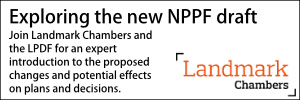Neighbourhood forum wins Planning Court challenge over Leeds site allocations plan and Green Belt land releases
- Details
A neighbourhood forum has successfully challenged Leeds City Council’s site allocation plan in the High Court in a dispute over calculating Green Belt release for housebuilding.
Aireborough Neighbourhood Development Forum made its challenge under s.113 of the Planning and Compulsory Purchase Act 2004.
It has been officially designated by Leeds as a neighbourhood forum under the Localism Act 2011 for the purposes of preparing the Aireborough Neighbourhood Plan.
Mrs Justice Lieven said there was a “somewhat tortuous history” to Leeds’ housing land supply because of the council’s difficulty in showing it has a five-year supply of deliverable housing land.
This was compounded by the council having adopted a figure for its housing requirement in its 2014 core strategy, which later had to be reduced to accord with revised national guidance.
The judge said Leeds found itself taking forward the site allocation plan to meet the housing requirements in the adopted core strategy while also conducting a selective review of that strategy to revise the figure downwards.
In Aireborough Neighbourhood Development Forum v Leeds City Council & Ors [2020] EWHC 1461 (Admin) Lieven J said: “As this case shows, that has led to considerable difficulty in the production of the site allocations plan and decisions around Green Belt release within the [plan]. These difficulties lie at the heart of this challenge.”
The strategy was adopted in 2014 and allocated 66,000 new dwellings for 2012-28, allowing for windfalls.
Proposed allocations included sites for 12,481 homes in the Green Belt, 972 of them within Aireborough.
But new national methodology produced by the Government made it “increasingly clear to the council that the figure of 66,000 was no longer sustainable and a materially smaller number of dwellings would now need to be delivered”, but it still had to demonstrate a five-year land supply.
The judge noted: “The council has struggled to show it has a five-year land supply as is required by national policy.”
Leeds had lost a number of planning appeals because of this and the council felt it needed a site allocations plan in place to avoid ‘allocation by appeal’.
The forum challenged the plan’s adoption on seven grounds.
Finding for the claimant, Mrs Justice Lieven upheld the challenge on the basis that:
- There had been a failure to provide adequate reasons as to the lack of need for Green Belt release (ground three);
- There had been a failure to give adequate reasons for the use of HMCAs [Housing Market Character Area] in the site selection process (ground four);
- There had been a failure to take into account the actual surplus in delivery to 2023 (ground seven). This was a material error of fact and that amounted to an error of law;
- There had been a breach of the Strategic Environmental Assessment Directive and Regulations requiring the consideration of "reasonable alternatives" (ground one), although the judge went on to say this would not have many a difference to the outcome.
On ground seven, Lieven J said she did not accept that the error identified by counsel to the claimant was either not material or such that the outcome, particularly in relation to the critical issue of Green Belt release, would have been inevitably or highly likely to have been the same in any event.
The judge said: “The level of the discrepancy is such as to wipe out the entire numerical need for the Green Belt release in the SAP (3,778 units).
“Even if the error figure was somewhat less…it would still materially diminish the need for Green Belt release, and in pure numerical terms remove it for Aireborough, where the Green Belt release figure was 475.
“Further, it is by no means necessarily the case that if the correct figures had been taken the inspectors would have reached the same view.”
It is understood that written submissions will now be made in relation to relief.
Mark Smulian
Sponsored articles
Walker Morris supports Tower Hamlets Council in first known Remediation Contribution Order application issued by local authority
Unlocking legal talent
Senior Lawyer - Planning, Property & Contracts Team
Principal Lawyer - Planning, Property & Contract
Lawyer (Planning and Regulatory)
Contracts Lawyer
Legal Director - Government and Public Sector
Locums
Poll








































